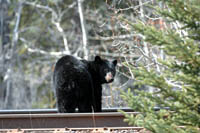
9 May 2007
CP Railway Cleaning Up its Tracks
| |

A black bear recently seen on the tracks by a local
photographer.
|
Leaky rail cars dumping grain along tracks inside Banff National
Park are going to be repaired over the next five years, but how long it will take for animals to stop frequenting the train routes is
unknown.
Wildlife like bears, elk, and deer are often on the rail tracks throughout the park searching for grain left by worn or defective
hopper cars.
This leaves them open to being hit by passing trains and since 2000, four grizzly bears have been killed and five cubs left orphaned by
their deaths did not survive alone in the wild, said Defenders of Wildlife executive director Jim Pissot.
Canadian Pacific Railway, long criticized for erroneously dumping the grain, plans to fix 6,300 government-owned train
cars over the next five years for $20 million with the hope foraging animals will avoid their tracks and oncoming trains.
The ownership status of the hopper cars had been in limbo, preventing any action up until this point.
"We really couldn't do much about it," said CP Rail spokesperson Mark Seland. "It took basically from May of last year
until now to get the parameters of an agreement together of who owns them, how they're maintained, and so on."
But much wildlife have been conditioned to search the railways for food and a generation or two may have to pass before bears and other
native Banff animals stop associating trains with food.
"We don't know quite how long it will take them to wean them away, but this is a great start," said Pissot. "We've got
at least three generations of grizzlies habituated to finding grain. CP has to be sure to clean all of the grain that is already there
because it's still important to get rid of those trace amounts."
Large amounts of dumped grain are sometimes seen directly on the tracks, but it's the smaller amounts that slide under the railway
supports that are a concern because they ferment and attract hungry animals.
CP Railway purchased a vacuum car to pick up dropped grain but Parks Canada officials said it's only good for large amounts, not the
tiny bits that trickle away.
"The thing with the grain on the tracks - once they get rewarded they tend to go back there," said Parks Canada's Ed Abbott,
manager of resource conservation in Lake Louise. "When you get a food attraction, they tend to ignore (train) whistles or any
other sounds."
And though the food supply on the tracks should be cleared up in five years, it may not keep animals away from trains completely.
"Wildlife are attracted to the train tracks for a number of reasons, not just grain," said Abbott, noting tracks provide
animals with a corridor of good visibility to travel along, as well as the promise of dandelions that grow along its borders.
Though wildlife will likely still frequent the tracks, CP is being praised for reducing the chances they'll end up on the railway when
a train comes by.
"It's a great step forward," Pissot said. "A bit overdue, but a great step forward."
|